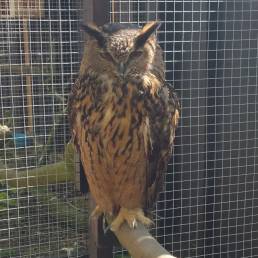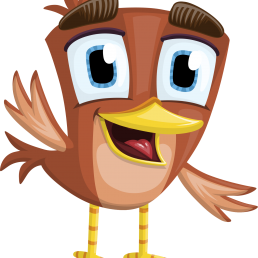Ollie the European Eagle Owl
Ollie is a European Eagle Owl, one of the largest of all the owls found in Europe, it was once found a cross Britain. It is best know for its large orange ‘pumpkin’ eyes and those eyes will just make you fall in love with Ollie.
European Eagle Owls prey mainly on mammals such as rabbits and hares, and even game birds, it is also known to take roe deer and foxes. They live for around 20 years in the wild and in captivity up to 60 years.
The European Eagle Owl (Eurasian Eagle Owl) is one of the world’s largest owls and measures between 23-30 inches in length and a wingspan of 55-79 inches. It has a large beak and powerful talons and distinctive orange eyes. The prominent ear tufts can be raised or lowered and its plumage is mostly mottled brown and black with darker streaks on the breast.

Description
The facial disc is tawny-buff, speckled with black-brown, so densely on the outer edge of the disc as to form a “frame” around the face. A narrow buff band, freckled with brown buff, runs up from the base of the bill, above the inner part of the eye and along the inner edge of the black-brown ear-tufts. The bill is blackish, the cere greyish-olive, and the eyes are bright orange-red to golden-yellow. Chin and throat are white continuing down the centre of the upper breast.
The upperparts are brown-black and tawny-buff, showing as dense freckling on the forehead and crown, stripes on the nape, sides and back of the neck, and dark splotches on the pale ground colour of the back, mantle and scapulars.
The rump and upper tail-coverts are delicately patterned with dark vermiculations and fine wavy barring. The tail is tawny-buff, mottled dark grey-brown with about six black-brown bars.
The whole of the underparts except for chin, throat and centre of upper breast is covered with fine dark wavy barring, on a tawny-buff ground colour. Legs and feet are likewise marked on a buff ground colour but more faintly. Claws are blackish-brown with black tips.
Diet
Eagle Owls have various hunting techniques, and will take prey on the ground or in full flight. They may hunt in forests, but prefer open spaces.
Eagle Owls will eat almost anything the moves – from beetles to roe deer fawns. The major part of their diet consists of mammals (Voles, rats, mice, foxes, hares etc…), but birds of all kinds are also taken, including crows, ducks, grouse, seabirds, and even other birds of prey (including other owls). Other prey taken include snakes, lizards, frogs, fish, and crabs.
The most common type of prey depends largely on relative availability, but are usually voles and rats. In some coastal areas, they have been known to feed mainly on ducks and seabirds.
Habitat
Besides being one of the largest living species of owl, it is also one of the most widely distributed, it’s found in many habitats but is mostly a bird of mountain regions, coniferous forests, steppes and other relatively remote places.
They have been found in habitats as diverse as northern coniferous forests to the edge of vast deserts, living in almost every climatic and environmental condition on the European continent, They are often found in the largest numbers in areas where cliffs and ravines are surrounded by a scattering of trees and bushes. Grassland areas such as alpine meadows or desert-like steppe can also host them so long as they have the cover and protection of rocky areas.
Did You Know?
- Eurasian Eagle-owls combine fast and powerful flights with shallow wing beats and long, fast glides. They also soar on updrafts, displaying a type of flight similar to that of soaring hawks like the Red-tailed Hawk.
- Eurasian Eagle-owls are among the world’s largest owls.
- Their pumpkin orange eyes and feathery ear tufts make them one of the most striking owls in the world.

Online Ollie
Ollie loves to sit and watch what’s going on in the garden. Like many owls he is mostly nocturnal, or active at night. Owls spend their days roosting, or resting, in a safe perch. If they spend too much time on the ground, even these top predators may fall prey to opportunistic ground predators like foxes. So while Ollie enjoys his rest we have created an online version who can help you find your way round the garden.
He is even wiser than old Ollie, and has the power of the internet behind him, so he can visit you online and answer your questions. So say hello to Online Ollie Today.
Get Involved
Ollie and His Friends Have Great Appetites
Why Not help us Feed Ollie and his friends, each year at the Garden our animals are fed and cared for by volunteers supported by the public. So if your would like to help us care for our animals why not donate today and then come join us for feeding time and meet your animals in person.
